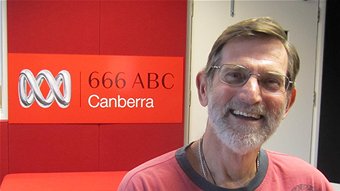 Carnaby's Black Cockatoo researcher Denis Saunders. Image: Gabrielle Rumble - ABC
Carnaby's Black Cockatoo researcher Denis Saunders. Image: Gabrielle Rumble - ABC
Dr Denis Saunders bounces into the studio at 666, having walked up Mt Painter this morning, on a breathtaking Canberra autumn day. Sometimes he and his golden retriever ("the leggy blonde") have done about 11 or 12 km before breakfast.
The fit as a fiddle scientist has dedicated his life to preserving Western Australia's Carnaby's Black Cockatoo.
Denis came to Canberra with his parents in 1960. His love of nature was ignited at the family's beach house at North Rosedale on the South Coast, precious hours spent exploring on his own.
At 13 or 14 years of age, he wanted to join the air force, like his father, but getting glasses at the age of 15 put paid to that. Instead, he went to the ANU to study chemistry, and had to take an extra subject - zoology. The die was cast.
"When I was at university the one thing I wanted to do was join the CSIRO," he said.
Denis introduced listeners to a wonderful concept that existed at the CSIRO in those days - the CDK "chief doesn't know" project. Scientists were allowed and encouraged to spend 10 per cent of their time on their own projects, and from this came some amazing, and groundbreaking research. Nowadays, they're more driven by what the funding can hold now.
"It's more difficult to run those CDK projects" said Saunders.
"Then, you could see your career path".
Beginning at the CSIRO at only twenty, Denis describes a culture where people felt they could see projects through over the course of their working life, "...and that's what happened with my black cockatoos".
Extremely modest, Dr Saunders described his PhD as being "handed to me on a plate", in recognition of the vast research he was doing on the Carnaby's black cockatoo. He's known by one Western Australian friend as the "Black duck doctor".
Listeners may have seen "On a Wing and Prayer" the spectacular documentary that screened recently on ABC1 about the black cockatoos of Western Australia. Denis Saunders describes the past practices of broad acre clearing of parts of the South West of Western Australia, "botanically one of the richest provinces in the world...it's just mind blowing".
"I was sent across to WA to work with Black Cockatoos because they were vermin. Seen by the CSIRO as animals of economic importance because they interfered with fruit crops."
Only once he was there he saw that their populations were dropping radically due to land clearing, and stamping them out turned to protection.
"It's heartbreaking, you have these very long lived birds.....used to see flocks of 3,000 and now you're lucky to see a flock of 100."
Denis explains about how climate change impacts on the black cockatoo - and it's an animal that doesn't have a lot of room to manoeuvre when it comes to climate change. The indigenous people describe the black cockatoo as a rain bird - Denis Saunders believes we should be listening more to that knowledge. Changes in seasons mean that the cockatoo's habitat will be dramatically reduced.
When asked about whether there's a hatred of scientists at the moment, Denis says he's been referred to as a crackpot in the media, but he says he's not running down farmers....they were asked to provide food and fibre, which they did. They had no guidance about conservation and only now are they being asked to be custodians of the land. "I've never come across personal vilification", Denis said.
"I love Canberra, it's my country". But Western Australia also has a special place in his heart, which brings Denis Saunders to another passion: the salmon gum.
"It's very special to see a sunrise or a moon rise through salmon gums. They have to be 150 years old to have a hollow that collects water for black cockatoos to drink from. We have no idea how old many of those salmon gums are. Some were probably alive long before Captain Cook was even born".
And what does Denis Saunders want from us? He wants us to ask - "What is this landscape going to look like in 150 years? Look at trees and all the species that depend on those trees for home. They form our iconic landscape and our vision of what we are."
Listen to the full interview with Dr Denis Saunders on the audio log.